The mold removal process is key to making a place safe and healthy. It starts with checking for mold, looking for moisture, and testing the air. This helps find out how bad the mold problem is and how contaminated the area is1.
This step is important to stop mold from spreading and to remove it well. For example, if mold covers more than 10 square feet, you need expert help1. Knowing how to remove mold is important for homeowners. Places like mold remediation services offer great advice on how to deal with mold.
Homeowners should check their homes often for mold to stop it from growing1. The mold removal process includes checking, containing, cleaning, throwing away moldy stuff, making everything clean, and checking again after1. For big mold problems, it’s best to get help from professionals to keep the building safe and people safe1.
Key Takeaways
- Understanding the mold removal process is key for a safe and healthy place.
- Mold remediation means checking, looking for moisture, and air quality tests.
- For big mold problems, get help from professionals.
- Check your home often for mold to stop it from growing.
- Mold can come back if you don’t fix moisture problems1.
- The cost to remove mold is about $2,360, between $1,225 and $3,7502.
Understanding Mold and Its Impact
Mold is a fungus that grows in moist, warm places. It can harm your health and buildings3. Mold spores are everywhere, inside and outside4. Keep indoor humidity below 45 percent to stop mold4.
There are many mold types, like black mold, which is very dangerous3. Mold can cause allergies, breathing problems, and asthma3. It’s important to get professional mold removal services or try DIY methods for safe removal.
Some important black mold removal tips are finding and fixing moisture sources. Use special filters and follow safe steps4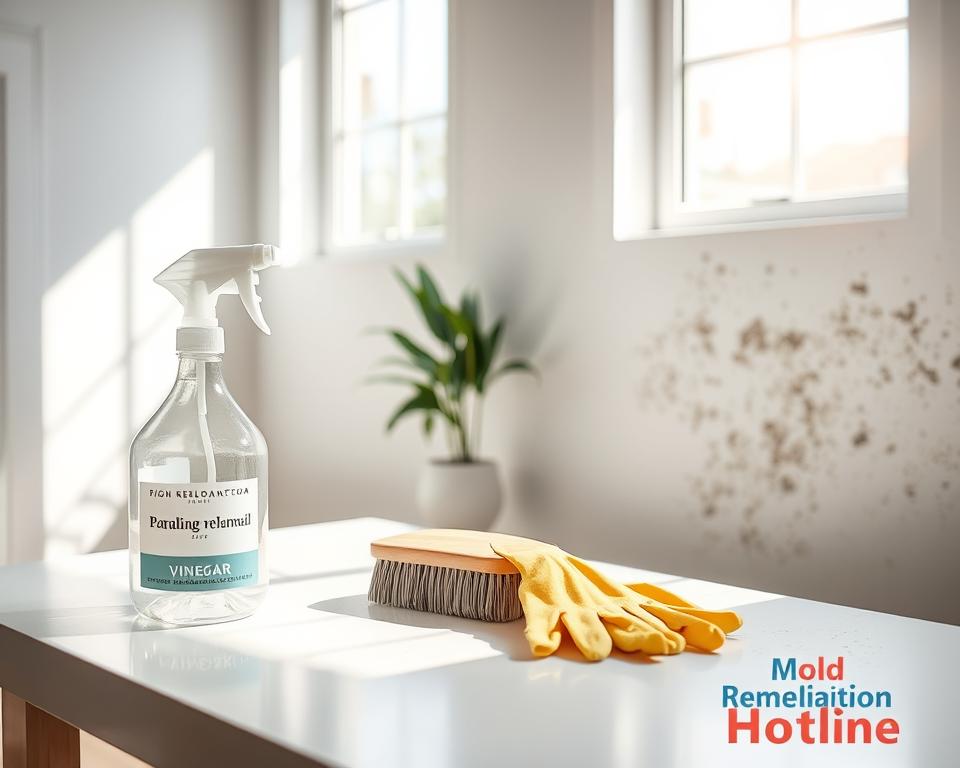
It’s key to know the difference between mold removal and remediation3. Remediation includes checking for mold, fixing water problems, and treating with special treatments3. By doing these steps, you can remove mold and stop it from coming back. You can use DIY mold removal techniques or get professional mold removal services.
| Type of Mold | Health Risks |
|---|---|
| Black Mold | Allergic reactions, respiratory infections, asthma |
| Other types of mold | Respiratory problems, skin irritation, eye irritation |
Signs of Mold Infestation
Mold can harm over 50% of homes in the U.S., causing damage and health risks5. It’s key to spot mold signs early to fix it. Look for musty smells, water damage, and mold spots.
Spotting mold can be tricky, but look for spots, smells, and irritation. If you see these signs, act fast. Delaying can cause big problems like damage and health issues6.
Some important signs to watch for are:
- Musty odors
- Visible mold growth
- Water damage
- Respiratory irritation
Use protective gear and good ventilation when removing mold. Knowing mold signs and acting quickly keeps your home safe and healthy.
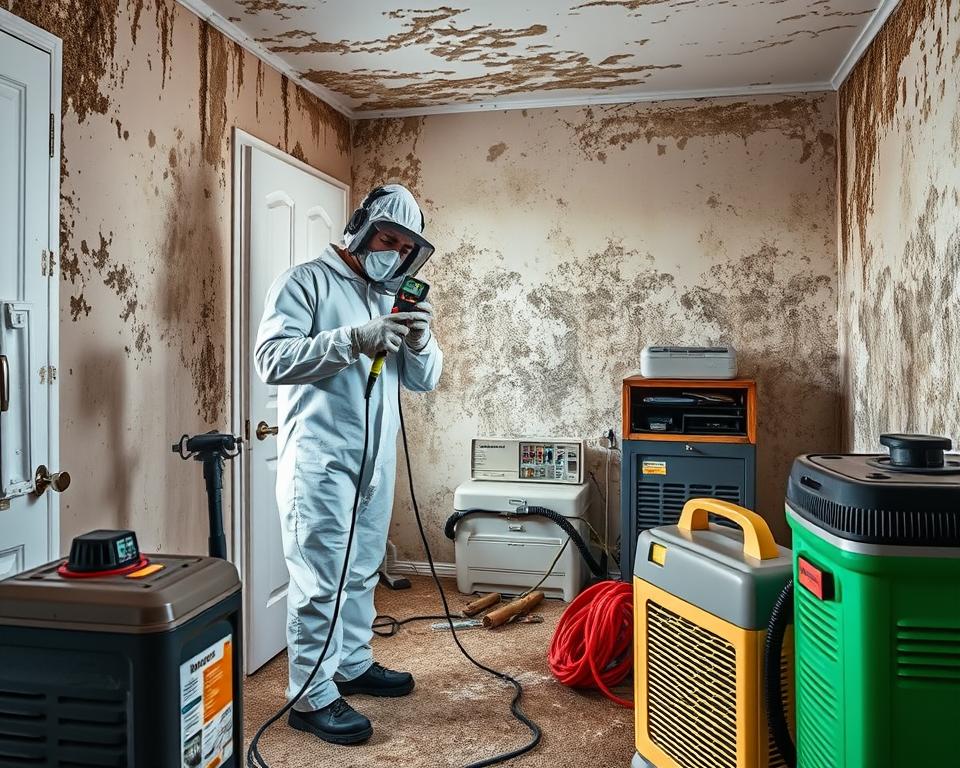
Being alert to mold signs and acting fast keeps your home safe. Always follow mold remediation steps and best practices for mold elimination for effective removal5.
| Signs of Mold Infestation | Description |
|---|---|
| Musty odors | Indicates mold growth, often in hidden areas |
| Visible mold growth | Visible signs of mold, often in damp or water-damaged areas |
| Water damage | Indicates possible mold growth, needs quick fixing |
Assessing the Infestation
Checking for mold is a key step in getting rid of it. It helps find out how bad the mold problem is and how much it has spread7. This is important for making a good plan to fight mold.
There are a few ways to check for mold. You can do it yourself by looking and checking for moisture. Or, you might need to call in experts for really bad cases.
Mold likes to grow where it’s wet and has food8. A pro can find these places and tell you how to fix them.
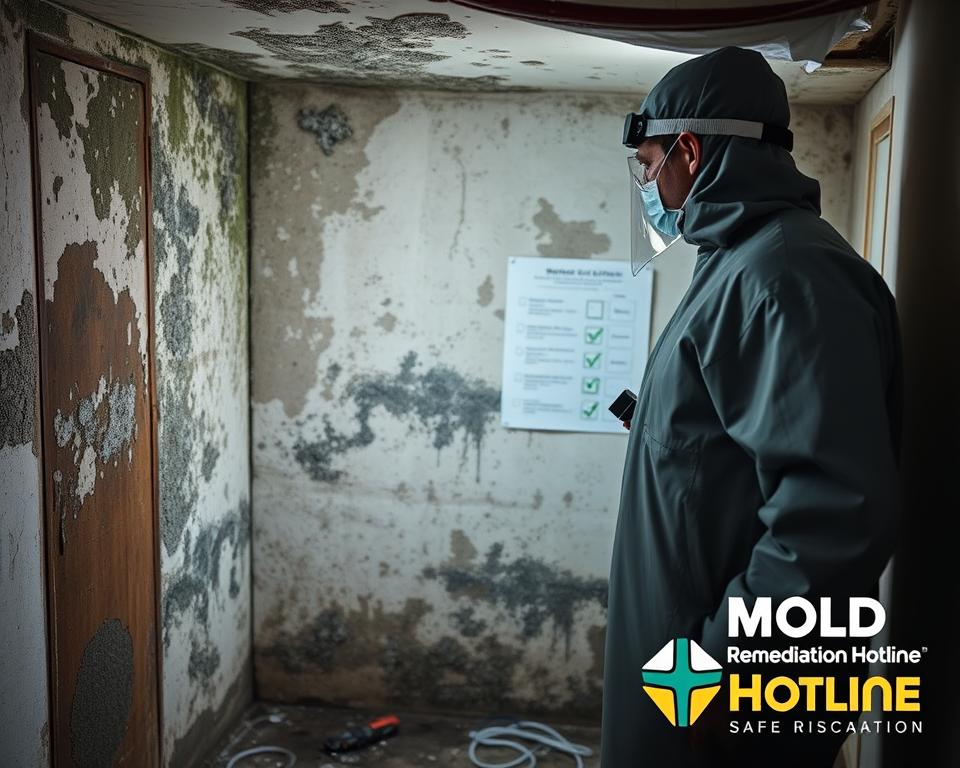
- How much mold there is
- How dirty it is
- What makes mold grow
Knowing these things helps you make a good plan to fight mold. You can choose to do it yourself or get help from experts7.
Safety Precautions Before Removal
When you’re doing DIY mold removal, safety is key. You don’t want to get mold on you or breathe it in. Mold remediation guidelines say to wear a NIOSH Approved N95 respirator to keep mold spores out of your lungs9. If you have allergies or weak lungs, it’s best to stay away from mold cleaning9.
To stop mold spores from spreading, open windows or doors. This helps keep the air clean10. You should also seal off the area you’re cleaning to keep mold from spreading further10. Wear face masks, gloves, and safety glasses to protect yourself10.
Remember, if the mold is over 10 square feet, call the pros. The Environmental Protection Agency says so10. By taking these steps, you can safely remove mold and keep it from coming back. 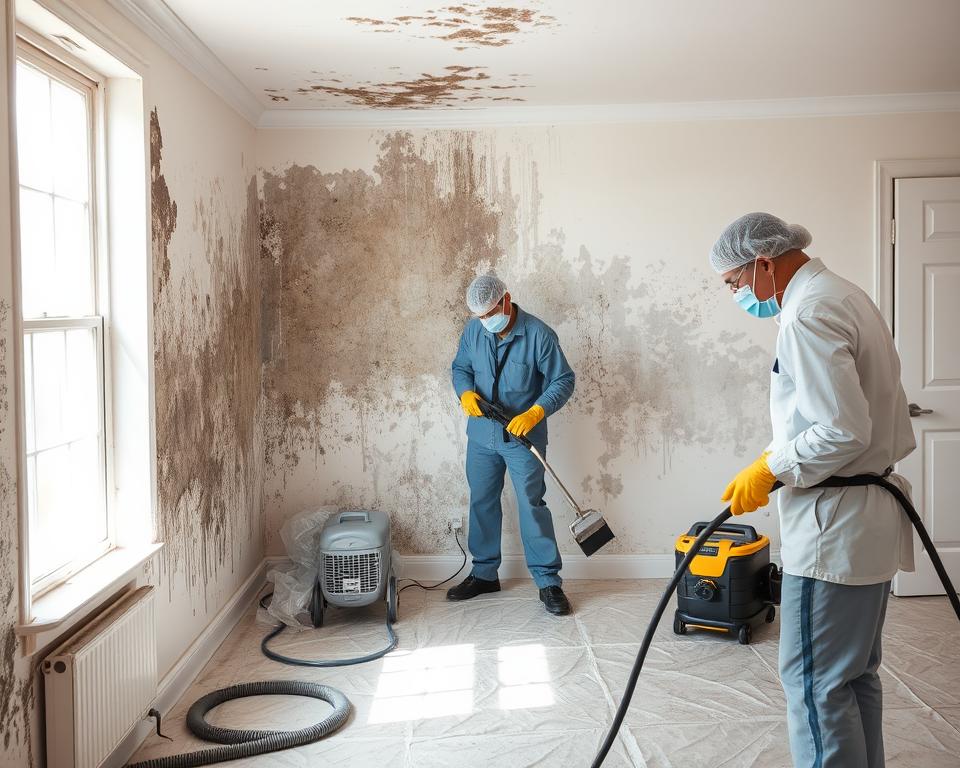
Here are some important safety tips for mold removal:
- Wear protective gear, including a NIOSH Approved N95 respirator9
- Ensure proper ventilation, such as opening windows or doors10
- Use containment measures, such as isolating the cleanup area10
- Avoid touching mold-contaminated materials with bare hands10
By following these safety tips and using the right methods, you can safely remove mold.
The Mold Removal Process: Step-by-Step
The mold removal process has many steps. First, you prepare the area. Then, you remove materials that have mold. Lastly, you clean and sanitize everything11. This makes sure mold doesn’t come back and keeps everyone safe.
It’s key to follow each step carefully. You need to check how bad the mold is, seal off the area, and get rid of moldy stuff12. If the mold is really bad, experts with special tools can help a lot11.
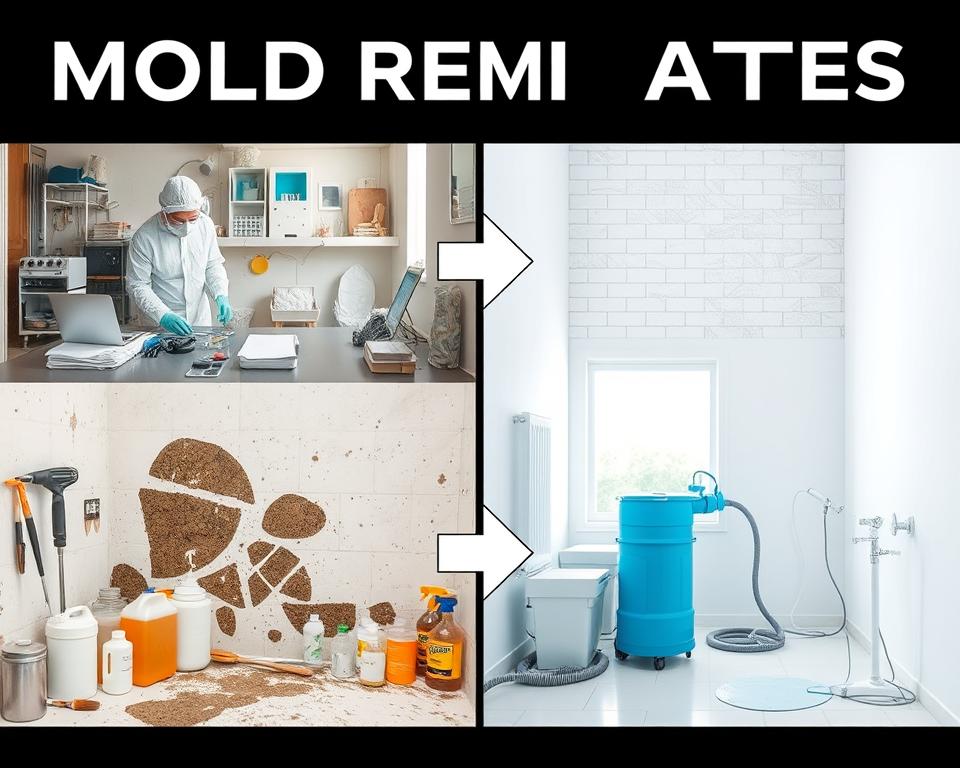
For some mold, you might need special tools like HEPA vacuums and wire brushes13. Keeping the air dry is also important. You should keep the humidity below 50%11. By following these steps and getting help when needed, you can get rid of mold and keep your place safe and healthy.
The Role of Preservation
Preservation is key to stop mold from growing. It’s important to follow a mold mitigation guide for good mold treatment. This means using products that fight mold and treating surfaces right, as shown in the source. By doing this, people can stop mold and keep their place safe and healthy.
Using mold-resistant products is a good way to stop mold. It’s also important to keep the air and humidity levels low. This helps control mold growth14. Also, change HVAC filters often, at least 4 times a year, and after mold outbreaks. Use filters that catch spores well14.
Some important things to think about for mold prevention and treatment are:
- Keep indoor humidity below 60% (best between 30-50%)15
- Use mold-resistant products and treat surfaces well
- Follow a mold mitigation guide and best practices for mold elimination
By following these tips and using good mold treatment methods, people can stop mold. This makes their place safe and healthy. For more info on mold remediation costs, visit mold remediation cost per square foot15.
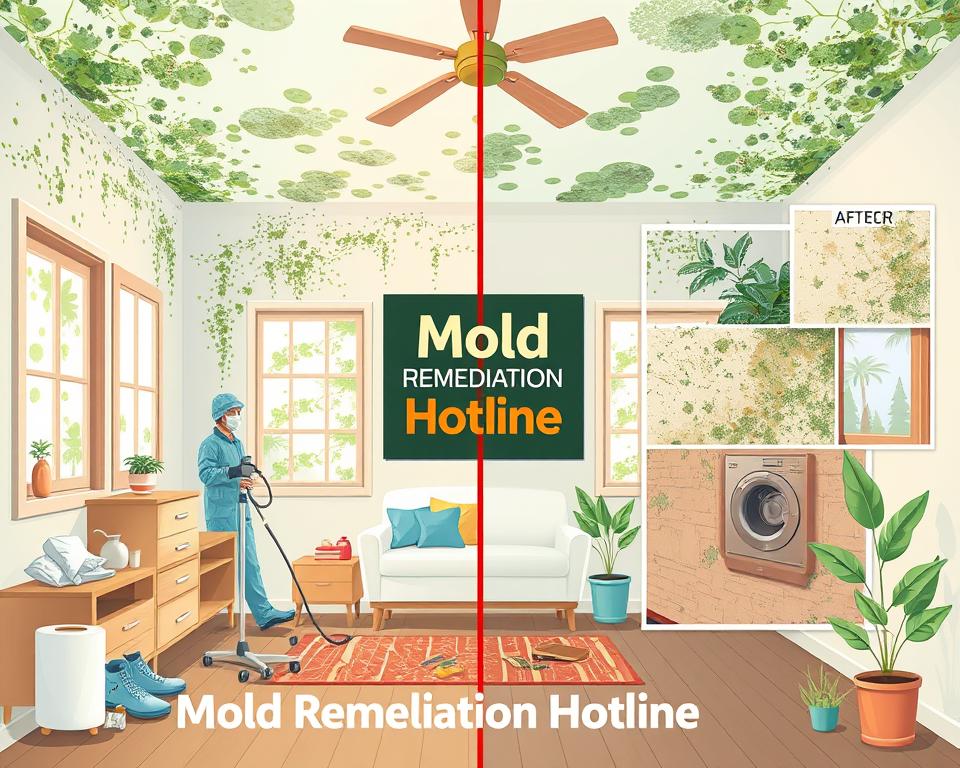
Post-Removal Assessment
After removing mold, it’s key to check if it’s all gone. This helps stop mold from coming back. You need to look for any mold left, watch humidity, and use control steps. Mold removal guidelines say you should get a licensed mold pro for big mold areas16.
The steps for checking after mold removal are:
- Look for any mold you can see
- Watch humidity to avoid too much moisture
- Use steps to control moisture and air, like better ventilation
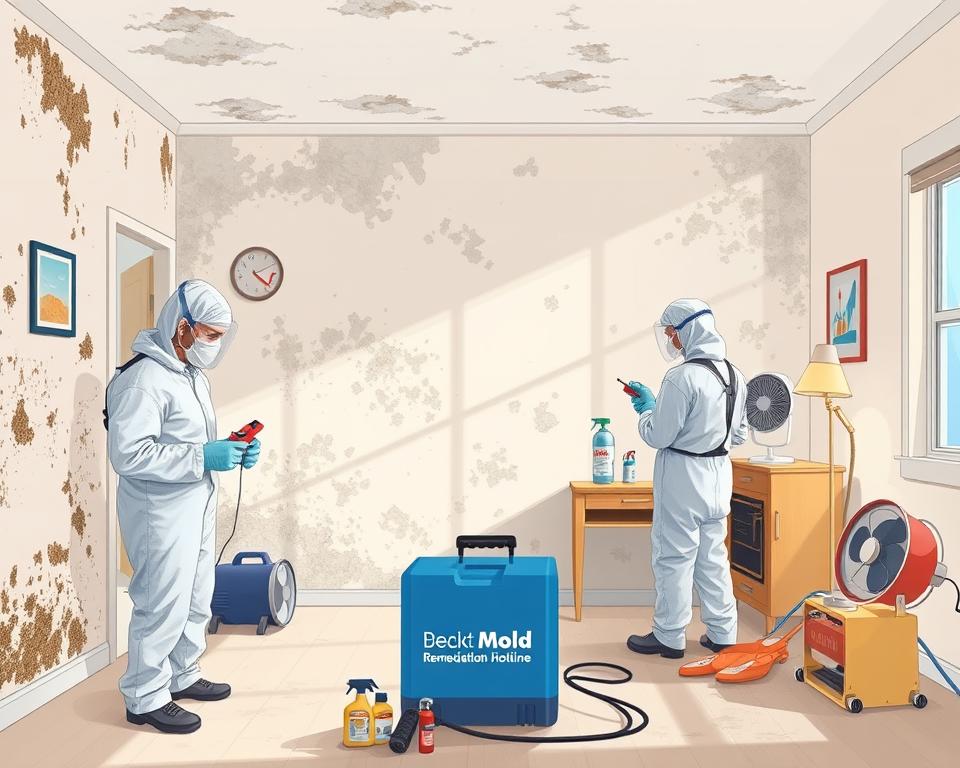
Checking air quality after mold removal is very important. It helps find any mold spores or bad stuff in the air. This makes sure the air is safe17. By following these steps and getting help from mold removal pros or doing it yourself, you can keep your place safe and healthy.
Professional Mold Removal Services
When you face mold problems, it’s smart to get help from experts. They know a lot about mold remediation steps and how to treat it well. They can give you a detailed mold mitigation guide to stop mold from coming back.
Mold can grow fast, starting in just 48 hours after water gets into your home. If your home’s humidity is over 45 percent, mold can grow too. Experts use special tools and follow effective mold treatment methods to remove it safely and well.
Getting professionals helps because they know what to do and have the right tools. They can also help make a mold prevention plan after they clean up to keep mold away18.
By using a detailed mold mitigation guide and effective mold treatment methods, you can make your home safe and healthy. For more info on mold removal, check out mold remediation hotline19.
Prevention Strategies
Stopping mold growth is key to a safe, healthy home. The mold removal process is complex. But, following good mold removal steps can help a lot. Keeping the air inside clean is also very important to stop mold20.
Regular checks and upkeep are important to stop mold. Look for signs like water damage or leaks. Fix these problems fast21. Keeping humidity levels between 30-50% is also key22.
Some good ways to fight mold include:
- Improving ventilation
- Reducing humidity
- Regularly checking for mold signs
By doing these things, people can stop mold and keep their homes safe and healthy20.
Also, using air scrubbers with HEPA filters can help get rid of mold spores in the air. This helps stop mold from growing20. Taking these steps can help keep homes safe and healthy. It follows the best mold removal practices and steps22.
Long-term Monitoring and Maintenance
After removing mold, it’s key to watch for it to come back. A good mold mitigation guide shows why keeping an eye on things is important. Using the right methods and getting help from pros can keep your home safe and healthy.
Some important steps for watching and taking care of your home include:
- Looking for mold signs often
- Keeping humidity between 30-50% to stop mold23
- Having good air flow, like after cleaning, to get rid of spores23
By doing these things and using good mold treatments, you can stop mold from coming back. Remember, mold can make walls, ceilings, and floors weak, more so in damp places24. Getting help from mold removal pros can tackle mold and find and fix moisture problems24.
For more tips on watching and caring for your home, talk to mold removal experts or use a detailed mold guide. These steps help protect your home and keep it safe and healthy.
Resources for Mold Removal
To keep your place mold-free, you need the right tools and advice. FEMA helps a lot, with tips on how to get rid of mold25. They also help with reporting mold and dealing with unfair treatment26.
Recommended Products and Tools
Choosing the right mold removal tools is important. You can use soap and water or a weak bleach mix for cleaning25. For big jobs, experts are best. They know how to handle it safely and right.
Maintaining a Proactive Approach
Being ready to stop mold is the best way. Fix water leaks fast, keep air clean, and check for mold often2527. This way, you avoid big mold problems later.
FAQ
What is the mold removal process?
What are the different types of mold?
What are the signs of mold infestation?
How do I assess the mold infestation?
What safety precautions should I take before mold removal?
What are the steps in the mold removal process?
What is the role of preservation in mold removal?
What should I do after the mold has been removed?
What are the benefits of hiring professional mold removal services?
What are some prevention strategies for mold growth?
How do I monitor and maintain mold removal long-term?
What resources are available for mold removal?
Source Links
- https://www.ecofmr.com/articles/mold-removal-vs-mold-remediation/
- https://www.thespruce.com/is-mold-remediation-worth-it-1822834
- https://www.artplumbingandac.com/indoor-air-quality/mold-remediation-understanding-effects-mold/
- https://www.servpro.com/resources/mold-remediation/mold-removal-process
- https://www.belfor.com/us/en/resources/when-is-mold-remediation-required/
- https://facilityexecutive.com/mold-contamination-look-out-for-warning-signs/
- https://pur360solutions.com/8-steps-to-successful-mold-remediation/
- https://hhenvironmental.com/articles/difference-between-mold-assessment-and-mold-remediation
- https://www.cdc.gov/mold-health/about/clean-up.html
- https://yourmoldsolutions.com/blog/7-safety-tips-for-mold-cleanup-and-remediation-tasks/
- https://www.coit.com/blog/healthy-home/how-do-mold-remediation-yourself-step-step-guide
- https://www.usacleanmaster.com/blog/steps-of-mold-remediation-service/
- https://www.moldsci.com/blog/posts/the-basics-of-mold-remediation-part-ii-of-iii-gross-removal-of-mold-growth-and-impacted-materials
- https://www.nps.gov/articles/000/preservation-matters-disasters-mold-on-cultural-resources-and-collections.htm
- https://ccaha.org/resources/managing-mold-infestation-guidelines-disaster-response
- https://dol.ny.gov/what-expect-when-you-hire-mold-assessor-or-mold-remediation-contractor-p-228
- https://floodandfire.com/2023/12/22/post-mold-remediation-home-reentry-timeline/
- https://www.greenhomesolutions.com/our-services/mold-testing-and-removal/
- https://www.servpro.com/resources/mold-remediation/mold-removal
- https://www.precisionenv.com/posts/mold-removal-steps-to-a-safe-and-clean-space
- https://orf.od.nih.gov/TechnicalResources/ORFPolicies/Pages/MoldPrevPolicy.aspx
- https://www.burns-enviro.com/blog/2024/august/top-strategies-for-effective-mold-remediation-an/
- https://www.coit.com/blog/healthy-home/what-do-after-mold-remediation
- https://www.krausrestoration.com/2024/08/23/understanding-the-mold-removal-process/
- http://publichealth.lacounty.gov/eh/safety/mold-home.htm
- https://www.cdph.ca.gov/Programs/CCDPHP/DEODC/EHLB/AQS/Pages/Mold.aspx
- https://www.servpro.com/resources/mold-remediation
